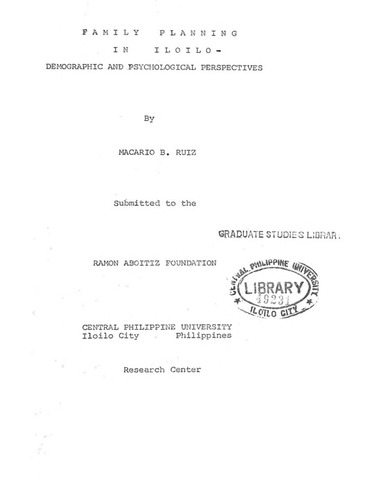Family planning in Iloilo: Demographic and psychological perspectives
| dc.contributor.author | Ruiz, Macario B. | |
| dc.coverage.spatial | Iloilo | en_US |
| dc.date.accessioned | 2021-11-12T00:02:34Z | |
| dc.date.available | 2021-11-12T00:02:34Z | |
| dc.date.issued | 1977-10 | |
| dc.identifier.citation | Ruiz, M. B. (1977). Family planning in Iloilo: Demographic and psychological perspectives (Research report). Jaro, Iloilo City: University Research Center, Central Philippine University. | en_US |
| dc.identifier.uri | https://hdl.handle.net/20.500.12852/1674 | |
| dc.description | Introduction and statement of the problem | en_US |
| dc.description.abstract | During the past five years or so, studies on population control and family planning have been conducted in this country, but most of these have been on the socio-economic field. We are not aware of studies on the psychological aspects, although it is possible that there are studies along this area but have not been reported. There are no studies on either the socio-economic or psychological aspects of population control in Iloilo Province, although several conferences and seminars have been held. Unfortunately, the data - if data were used at all as a frame of reference in the discussions - were based on studies conducted elsewhere. In colleges and universities in the province, where population education is a required course, information on the local situation is not available. This is why we have launched this study, even as we have been confronted by the many constraints in time, money, and manpower. The main thrust of this study was to determine which of certain pre-determined psychological variables are associated with fertility, fertility being defined in this context as the number of pregnancies. However, we were aware that socio-demographic variables like place of residence, socioeconomic status, and educational attainment have been found to be associated with the number of children. For this reason, we also included some socio-demographic variables so that these could be treated alongside with the psychological variables. This, hopefully, would present a much broader perspective of the entire population control problem in Iloilo. | en_US |
| dc.description.sponsorship | Ramon Aboitiz Foundation | en_US |
| dc.format.extent | vi, 275 leaves | en_US |
| dc.language.iso | en | en_US |
| dc.subject.ddc | GSL Theses 301.426072 R859 | en_US |
| dc.subject.lcsh | Birth control | en_US |
| dc.subject.lcsh | Family planning | en_US |
| dc.subject.lcsh | Fertility, Human | en_US |
| dc.subject.lcsh | Fertility | en_US |
| dc.subject.lcsh | Fertility, Human--Economic aspects | en_US |
| dc.subject.lcsh | Philippines--Iloilo (Province) | en_US |
| dc.title | Family planning in Iloilo: Demographic and psychological perspectives | en_US |
| dc.type | Technical Report | en_US |
| dcterms.accessRights | Limited public access | en_US |
| dc.description.bibliographicalreferences | Includes bibliographical references | en_US |
Files in this item
This item appears in the following Collection(s)
-
Research reports [167]


